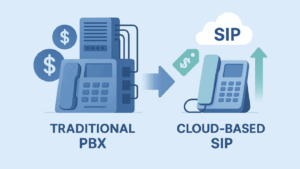
Which Types of PBX Systems Can Be Used with SIP Trunk Service?
A study found that 70% of all North American businesses use SIP trunks. Why? Because businesses love reducing communications costs. Saving up to 60% on long distance charges alone is a great idea.
SIP trunk service is an effective way to reduce communications outlay without losing quality. SIP trunks connect businesses to the phone system, but you still need a solution for call management and other telephony features. A PBX phone system supports a range of useful features and general telephone service.
If you want to minimize costs, there are very low-cost, or even free, open-source PBX choices. Read on to learn about types of PBX systems that work with SIP trunks.
What Are PBX Systems?
PBX (Private Branch Exchange) systems aren’t a new technology. In 1930, that meant an exposed wiring panel with sockets. The operator spoke to each caller then plugged wires to complete the connections for calls.
This system handled routing and switching of calls between businesses and the telephone network.
“Private” means that it was separate from the telephone system, even though it connected to it. The main communication circuits are called trunk lines. “Branch” refers to the endpoints that handle smaller amounts of traffic. “Exchange” describes connections that go through a switching exchange. This allowed a large number of calls to be routed through limited lines.
Although the method of providing these features has changed, the need for them continues.
What Does a PBX Do?
The work of the operator was automated and the socket switchboard went away. However, a PBX was a large, expensive machine located at a business. It wasn’t easily expandable or changed.
However, you could count on them for a few things.
- Allow the use of more than one telephone line
- Manage incoming and outgoing calls
- Split a single phone line into multiple internal extensions
- Automatically switch calls to the appropriate internal line
- Allows internal communication within the business
- Newer systems include voicemail, automated response and more
Modern PBX systems do all of this and more. An IP-enabled (internet protocol) PBX system can be located at your business or somewhere offsite to take advantage of your SIP trunk service.
How Does a Modern PBX Work?
What once needed rows of operators and a few dozen switchboards now fits onto circuit boards. Instead of acting as the bridge between the phone company trunk telephone lines and your company, it functions as a bridge between your company and your SIP trunk service.
At the center of a PBX is a specialized computer. It evaluates the routing needs of calls and data, simultaneously routes many links, and allocates limited bandwidth. A digital PBX changes voice communications to a digital signal for transmission.
This signal may be carried via ISDN. A digital PBX may use a protocol proprietary to the particular service provider.
An IP-enabled PBX is a digital system that uses internet protocol, an open-source set of standards adopted by many service providers. This allows the signal to be carried via the internet.
Onsite Legacy PBX
Onsite systems offer direct control of the phone system. When a business needs to expand, change, or delete lines from the system, an IT employee can handle it. This requires a high level of expertise from the employee, however.
Because of the large capital investment required for an onsite PBX system, many businesses want to continue using a legacy system. A special bridge is needed to transfer a compatible PBX from a telephone trunk to SIP trunk service.
IP-enabled digital systems owned and maintained by your business are no longer the only option. Most businesses now choose a hosted PBX system.
Hosted PBX for Your SIP Trunk Service
Hosted PBX options move the phone system, configuration woes and maintenance to a service provider. Complex programming and configuration are no longer the responsibility of your business. Onsite IT support need only worry about basic telephone handsets and cords.
Hosted systems are like an onsite PBX except they are located at the service provider’s center. Virtual or cloud PBX is used interchangeably with hosted PBX. For example, check out our SIP PBX for functions you really need with an easy to control interface.
Why Choose Hosted PBX?
There are four simple reasons to choose a virtual PBX.
- Cost
- Flexibility
- Convenience
- Scalability
As mentioned, owning and maintaining a PBX on-premises takes skilled employees. Skilled IT technicians are in high demand and expensive. There is also the matter of capital outlay for the equipment and cost of the space needed to house the equipment.
Hosted PBX gives you the functions you want for a low monthly charge and very limited capital outlay if any.
Hosted PBX systems are flexible and scalable. Easily increase or decrease the number of extensions with a few keystrokes. They can allow a business to add or change locations with the same phone system. Most importantly, it has the convenience of accessibility from any location with an internet connection.
Pair an open-source PBX with SIP trunk service for an excellent way to slash costs.
Open Source PBX Systems
Imagine all of the state-of-the-art unified communications features you need. Now imagine not paying for hardware or software to run your telephone system. Open-source PBX systems are a service where you pay for the server time and any consulting to get your system up and running– and that’s it.
They are very popular with companies making the switch to SIP trunk service. SIP.US is compatible with almost all open source systems. For example:
Asterisk
There are more than one million Asterisk-based communications platforms. It is a free, open-source platform for building communications applications. It is one of the most popular programs paired with SIP trunks. It runs on an ordinary PC and can serve as the base for a complete business phone system.
FreePBX
FreePBX is an open-source graphical user interface. It controls and manages Asterisk. Install and configure it alone, or as part of a distribution bundle with the OS, Asterisk the GUI and other dependent software. FreePBX is easy to use, configure and run. It is appropriate for cloud or onsite management.
FreeSWITCH
Another popular choice is FreeSWITCH. This software offers a unified communications infrastructure to support audio, voice, text and other media. It uses other free software and supports of a number of audio codecs. It ideal for SIP trunk service.
It was designed for easy configuration and customization. The software comes ready to enable basic functionality. Additional plug-ins can be added.
There are many other open-source options available in the market. If you select the open-source route for your business communications needs, make sure that your SIP trunk provider can support these types of solutions.
Can You Hear Me Now?
IP-based PBX systems use the same networking systems like e-mail, web browsing, and other online functions. VOIP (Voice Over IP) calls use a different technology from that of voice calls over the old analog lines. Traditionally-wired systems were superior to early VOIP calls.
Although there are far fewer call-quality concerns on modern systems, voice calls use bandwidth. High quality, stable SIP trunk service ensures that calls aren’t dropped or too mangled to understand. SIP.US allows users to bring their own bandwidth.
In addition, modern virtual PBX systems integrate communications services and allow you to go with one service provider. This simplifies billing and support challenges.
PBX Systems for SIP Trunks
Choosing the right PBX system to make the most of your SIP trunk service is important. Look for the services you need and compare costs. For many businesses making the switch to internet-based telephones, look at call quality among other criteria.
SIP trunk service unlocks huge cost savings for businesses that use voice calling and data constantly. Not only can you save on outbound calling, but also you control the costs of customers calling you.
Hosted PBX systems mean that none of the responsibilities for configuration or maintenance fall on your IT staff. They don’t have to struggle with data directories, inaccurate call routing, poor sound quality, or dropped calls.
Voice communications are still a favored form of connection. Some people still prefer phone calls, and delivery of consistent quality is good for your brand trust.
SIP trunk service is all about creating a flexible phone system that works with your business. Seasonal work, shifts in work patterns, etc. are no problem. SIP trunk service lets you add, subtract or change your order at any time.
Ready to get started with connecting your PBX to your SIP trunk service? Fill out this form to create a free SIP trunk account today to try it out!


